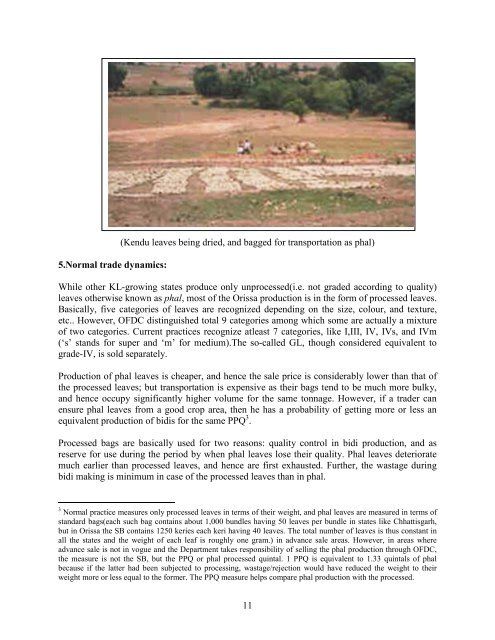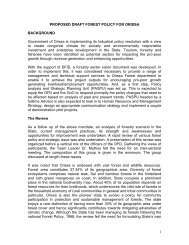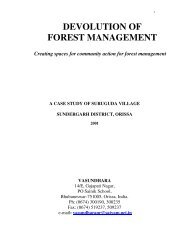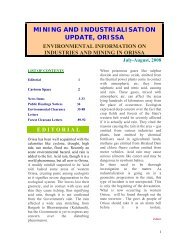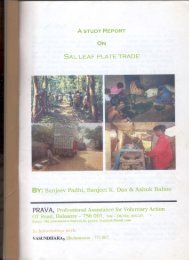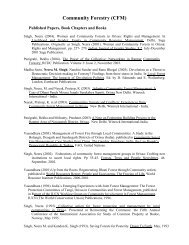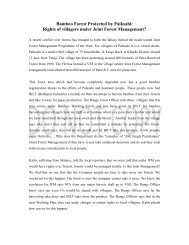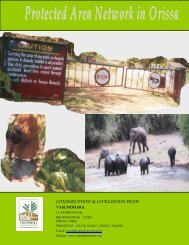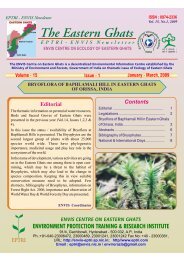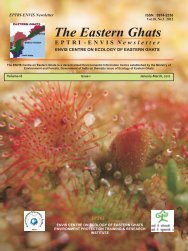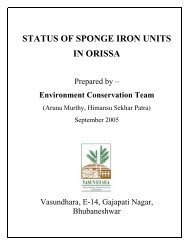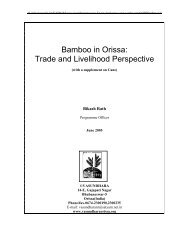The Kendu Leaf Trade: Problems & Prospects in Orissa - Vasundhara
The Kendu Leaf Trade: Problems & Prospects in Orissa - Vasundhara
The Kendu Leaf Trade: Problems & Prospects in Orissa - Vasundhara
Create successful ePaper yourself
Turn your PDF publications into a flip-book with our unique Google optimized e-Paper software.
5.Normal trade dynamics:<br />
(<strong>Kendu</strong> leaves be<strong>in</strong>g dried, and bagged for transportation as phal)<br />
While other KL-grow<strong>in</strong>g states produce only unprocessed(i.e. not graded accord<strong>in</strong>g to quality)<br />
leaves otherwise known as phal, most of the <strong>Orissa</strong> production is <strong>in</strong> the form of processed leaves.<br />
Basically, five categories of leaves are recognized depend<strong>in</strong>g on the size, colour, and texture,<br />
etc.. However, OFDC dist<strong>in</strong>guished total 9 categories among which some are actually a mixture<br />
of two categories. Current practices recognize atleast 7 categories, like I,III, IV, IVs, and IVm<br />
(‘s’ stands for super and ‘m’ for medium).<strong>The</strong> so-called GL, though considered equivalent to<br />
grade-IV, is sold separately.<br />
Production of phal leaves is cheaper, and hence the sale price is considerably lower than that of<br />
the processed leaves; but transportation is expensive as their bags tend to be much more bulky,<br />
and hence occupy significantly higher volume for the same tonnage. However, if a trader can<br />
ensure phal leaves from a good crop area, then he has a probability of gett<strong>in</strong>g more or less an<br />
equivalent production of bidis for the same PPQ 3 .<br />
Processed bags are basically used for two reasons: quality control <strong>in</strong> bidi production, and as<br />
reserve for use dur<strong>in</strong>g the period by when phal leaves lose their quality. Phal leaves deteriorate<br />
much earlier than processed leaves, and hence are first exhausted. Further, the wastage dur<strong>in</strong>g<br />
bidi mak<strong>in</strong>g is m<strong>in</strong>imum <strong>in</strong> case of the processed leaves than <strong>in</strong> phal.<br />
3 Normal practice measures only processed leaves <strong>in</strong> terms of their weight, and phal leaves are measured <strong>in</strong> terms of<br />
standard bags(each such bag conta<strong>in</strong>s about 1,000 bundles hav<strong>in</strong>g 50 leaves per bundle <strong>in</strong> states like Chhattisgarh,<br />
but <strong>in</strong> <strong>Orissa</strong> the SB conta<strong>in</strong>s 1250 keries each keri hav<strong>in</strong>g 40 leaves. <strong>The</strong> total number of leaves is thus constant <strong>in</strong><br />
all the states and the weight of each leaf is roughly one gram.) <strong>in</strong> advance sale areas. However, <strong>in</strong> areas where<br />
advance sale is not <strong>in</strong> vogue and the Department takes responsibility of sell<strong>in</strong>g the phal production through OFDC,<br />
the measure is not the SB, but the PPQ or phal processed qu<strong>in</strong>tal. 1 PPQ is equivalent to 1.33 qu<strong>in</strong>tals of phal<br />
because if the latter had been subjected to process<strong>in</strong>g, wastage/rejection would have reduced the weight to their<br />
weight more or less equal to the former. <strong>The</strong> PPQ measure helps compare phal production with the processed.<br />
11


